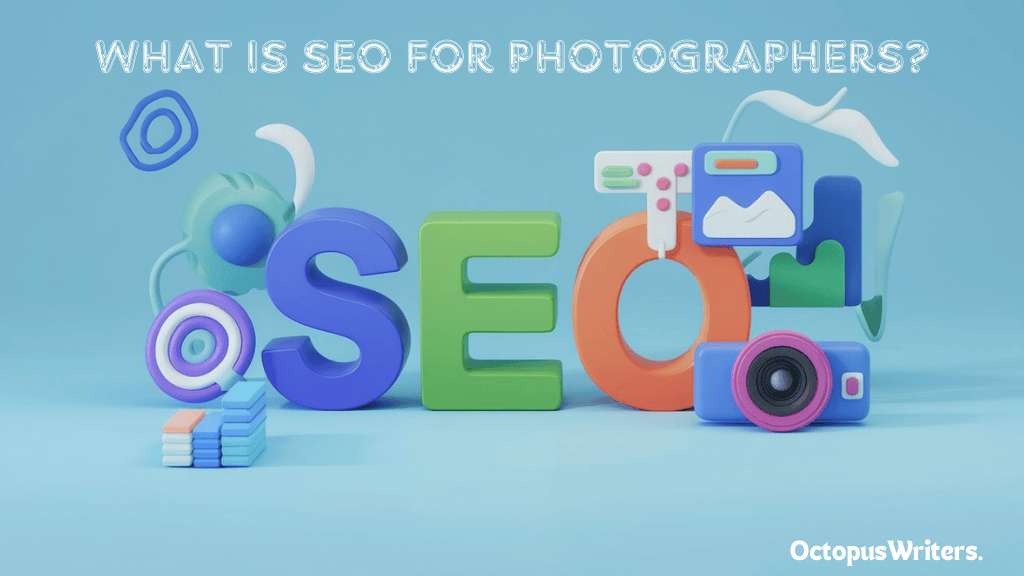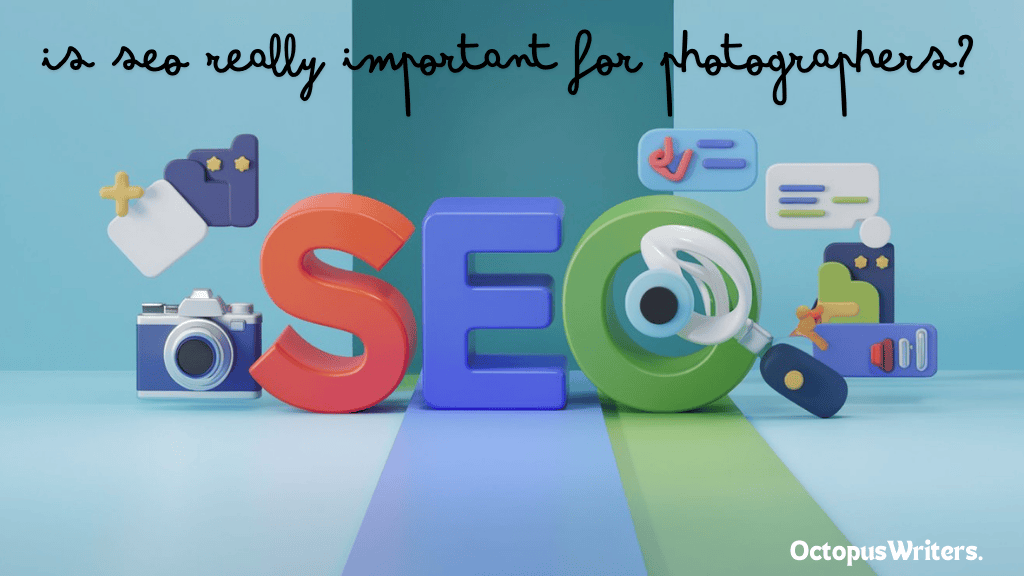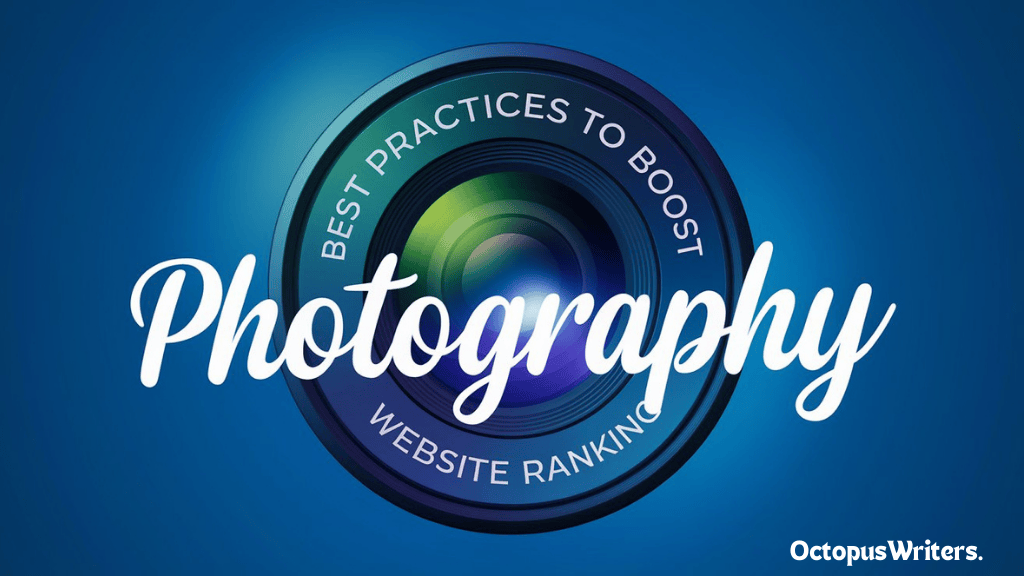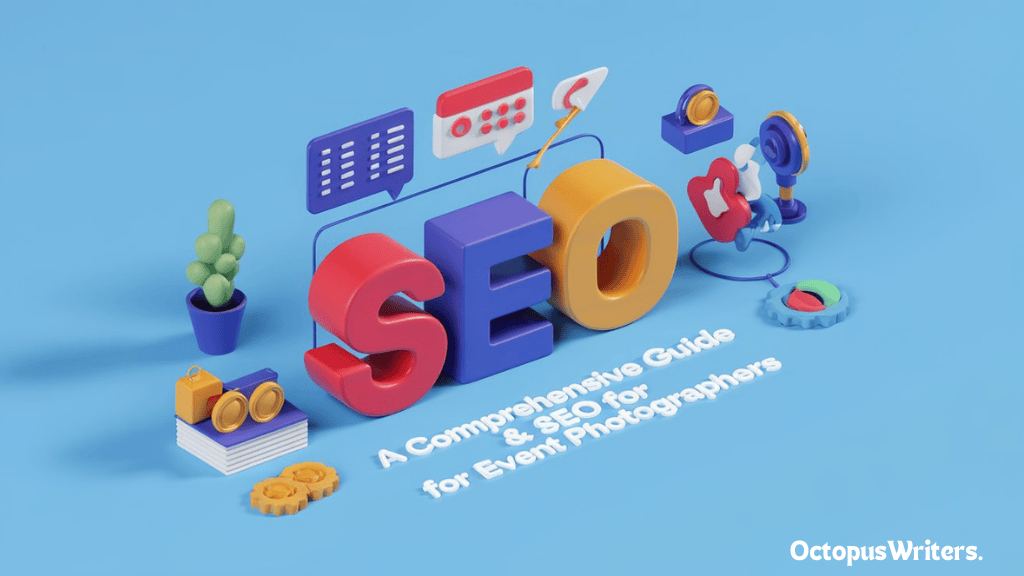Are you a photographer aiming to expand your reach? SEO for photographers can be the game-changer that propels your business forward. Today, most people turn to search engines to find photographers for special occasions like weddings, birthdays, and other events.
To stand out, you need two essential tools: a professional website and effective SEO strategies to boost its visibility.
When prospective clients search for photographers online, they are most likely to contact the ones appearing prominently on platforms like Google or Bing. By optimizing your website, you can significantly improve your chances of converting these searches into inquiries.
In this guide, OctopusWriters will walk you through practical and straightforward SEO techniques tailored for photographers. These tips will help you enhance your website’s performance and attract more clients to grow your photography business.
What Is SEO For Photographers?

SEO for photographers refers to a collection of strategies designed to improve your photography website’s search engine rankings. By leveraging SEO, photographers can attract more traffic and enhance their online reputation, making it an indispensable tool for marketing in the digital age.
Key aspects of SEO for photographers include optimizing images, writing detailed blog posts, creating visually appealing albums, ensuring mobile responsiveness, improving website speed, and incorporating practices like canonical tagging, guest blogging, and backlink building.
These strategies fall into three main categories: on-page SEO, off-page SEO, and technical SEO. If you’re unfamiliar with these terms, don’t worry we’ll explore them in depth later in this blog.
Is SEO Really Important For Photographers?
In today’s competitive digital landscape, SEO for photographers is essential for boosting visibility and reaching potential clients. Search engine optimization acts as the driving force that helps your photography website appear prominently on search engines like Google.

While there are many ways to grow your photography business, online visibility is key to success in the digital era. SEO allows you to stand out and reach your target audience more effectively. As digital marketing continues to dominate, SEO has proven to be one of the most cost-efficient methods for increasing customer engagement and conversions.
Consider this: according to research, the average person spends nearly 7 hours online every day. This makes it clear that investing in tools like SEO for photographers is not just smart it’s necessary. By integrating effective SEO strategies, you can build a strong online presence and attract the clients you’re looking for.
SEO Vs. PPC: Which Is Better For Your Photography Website?

When it comes to marketing your photography website, SEO and PPC (Pay-Per-Click) are two highly effective options. Both can drive traffic to your site, but their methods and benefits differ significantly.
| SEO | PPC |
| Generates organic traffic. Potential clients can discover your site naturally through search engines. | Delivers immediate results. PPC campaigns direct traffic to your site as soon as the ads go live. However, traffic stops if you pause your campaigns. |
| Builds credibility. Studies show that 45.1% of users trust and click on organic search results, compared to just 1.8% who click on PPC ads. | Ensures rapid visibility. PPC ads allow you to target specific keywords and gain instant exposure. |
| Offers long-term benefits. Once optimized, SEO continues to generate traffic for years. | Provides flexibility with costs. Although PPC can be expensive, you can set daily budgets and control your spending. |
| Cost-effective over time. There’s no ongoing cost for clicks once your site ranks well. | Premium positioning. PPC ads always appear at the top of search results, increasing visibility. |
If your goal is sustainable, long-term growth, SEO for photographers is the ideal choice. On the other hand, PPC is a great option for those seeking immediate results or running time-sensitive campaigns.
By combining both strategies, you can create a well-rounded marketing plan that drives consistent traffic and builds a strong online presence for your photography business.
23 Best Practices To Boost Photography Website Ranking
SEO for photographers involves multiple strategies, but you don’t have to be an expert to start optimizing your site. Here are 23 essential SEO practices to help improve your photography website’s ranking on search engines.

Get Reliable Hosting
Investing in a dependable hosting provider is critical for your website’s performance and security. Avoid shared hosting plans that lack modern technologies like the latest PHP versions and SSD storage. While cost is a factor, your decision should prioritize speed, reliability, and excellent customer service.
Opt for hosting services with fast load times and minimal downtime. Reliable hosting improves your site’s loading speed a key factor in SEO for photographers and ensures your website remains secure and accessible. Do your research, and if needed, check our recommended hosting providers tailored for photographers.
SSL Certificates
Switching to HTTPS is now a fundamental SEO ranking factor. Websites without HTTPS often display warning messages in browsers, deterring users.
An SSL certificate is crucial if you collect personal information or run an online store. It encrypts sensitive data, protecting both you and your users. There are free and paid SSL options, and many hosting providers offer this as part of their services. After implementing an SSL certificate:
- Verify the setup with your hosting provider.
- Update your Google Analytics and Google Search Console to reflect the new HTTPS URL.
- Redirect all old HTTP links to HTTPS to retain traffic and SEO benefits.
Think of this switch as launching a new website missing redirects can lead to traffic loss.
Optimize Title Tags
Title tags are clickable links that appear in search engine results, serving as a key indicator of your page’s content to both users and search engines. Optimizing them is a simple yet impactful step in SEO for photographers. Here’s how to create effective title tags:
- Keep them between 50-60 characters.
- Include target keywords to align with search queries.
- Ensure each page has a unique, engaging title to attract clicks.
Skipping title tag optimization can confuse search engines, reducing your site’s visibility.
Craft Descriptive Meta Descriptions
Meta descriptions are short, informative snippets summarizing a page’s content. They play a vital role in improving your click-through rate (CTR), which indirectly boosts your SEO. Best practices for writing meta descriptions:
- Limit them to 155 characters.
- Use actionable language with a clear call-to-action.
- Incorporate your primary keyword naturally.
- Make them unique for every page on your site.
When writing meta descriptions, prioritize user engagement over technical SEO. Focus on persuading readers to click by offering a compelling summary of what they can expect on the page.
Content With Targeted Keywords
Google has made it clear that high-quality content is one of the most critical factors for ranking well in search results. Its algorithms prioritize content that is relevant, user-focused, and engaging, reflecting Google’s commitment to delivering the best possible results.
For photographers looking to optimize their websites, SEO for photographers relies on producing content that balances keyword targeting with natural, user-friendly language. Avoid keyword stuffing at all costs. Instead, aim to seamlessly integrate relevant terms into blogs and service pages.
For example, top-ranking pages for search terms like “best wedding photographer” or “top birthday photography” often maintain keyword densities below 0.8%. The goal is to write content that resonates with readers while subtly incorporating target keywords to improve visibility. Without unique, optimized content, even the best SEO strategies may fall short.
Use Heading Tags And Keyword Phrases

Heading tags (h1, h2, h3, etc.) are essential for structuring your content. They guide search engines by clearly defining the hierarchy of information on your pages. Without these tags, your content may appear as an unorganized wall of text to Google’s crawlers. Here’s how to use heading tags effectively:
- H1: Reserved for the main page title.
- H2: Used for subheadings that organize key sections.
- H3 and beyond: For subcategories under H2 headings.
For improved SEO for photographers, incorporate focus keywords into your headings, especially in titles and H1 tags. Doing so not only enhances your rankings but also makes your content more readable and appealing to users.
Internal Page Linking
Internal linking is a powerful SEO practice that connects your photography website’s pages, improving navigation and helping search engines index your site effectively.
Here’s an example: if you’re reading a page about SEO for photographers, and it includes a link to a guide on social media marketing for photography businesses, you’re more likely to click and explore further. This increases time spent on your site, improving user engagement metrics a signal Google values.
Similarly, when a Google bot crawls page A of your website and finds a link to page B, it also indexes page B. To maximize SEO benefits, ensure that your pages link to relevant internal content.
Use ALT Tags For Images
Image alt tags are critical for both accessibility and SEO. They describe the content and purpose of images, enabling search engines to “read” and understand visuals. Without alt tags, Google cannot interpret what an image represents, which could negatively impact your ranking.
To boost SEO for photographers, always include descriptive alt text for every image on your site. Think of these tags as a meta description for your images. By accurately describing the subject and context, you help search engines index your content better and improve your website’s visibility on image searches.
Skipping alt tags means missing an opportunity to optimize your site’s SEO and enhance user experience. For photographers, where visuals are paramount, this step is especially crucial.
Use SEO Plugins
Using an SEO plugin is a great way to optimize your photography website, but installing and activating it isn’t enough. To truly benefit, take time to understand the plugin’s features, configure it correctly, and then apply its tools effectively. Here are three recommended plugins for SEO for photographers:
- Yoast SEO: This popular plugin helps add keywords, meta descriptions, and featured images for pages, enhancing your site’s SEO. It also provides suggestions for content optimization in real time. If your site uses Flexblocks or other custom fields, you may need an additional Yoast plugin to analyze and optimize that content.
- All in One SEO: Another solid choice, this plugin allows for keyword integration, meta descriptions, and social sharing features to improve your website’s visibility.
- Rank Math: Dubbed the “Swiss Army Knife of WordPress SEO,” this relatively new plugin offers a robust set of free features, making it a favorite among many photographers.
Avoid Duplicated Pages
Years ago, duplicating pages and tweaking keywords was a common SEO trick, but today it’s ineffective and could result in penalties. Instead, create unique, high-quality content for similar pages or blog posts.
Showcase your own work whether it’s weddings, styled shoots, workshops, or travel photography. Combine these images with engaging stories that naturally incorporate your target keywords. By doing this, you align your efforts with the best practices of SEO for photographers, improving your site’s rankings without risking penalties.
Use Canonical Tags
If identical content exists on multiple URLs within your site, use canonical tags to indicate the master version of a page. According to Moz, a canonical tag signals to search engines which URL to prioritize, avoiding duplicate content penalties.
For photographers, where portfolios or galleries may overlap across pages, implementing canonical tags is a vital strategy to ensure your SEO efforts are not diluted.
Check Indexing
Google may remove websites from its index if they violate quality guidelines, fail to comply with legal requirements, or provide poor user experiences. Regularly check your site’s indexing status to identify and resolve coverage issues.
Tools like Google Search Console allow you to monitor your indexing and address any red flags. Staying proactive ensures your photography website remains visible and competitive.
Ensure Mobile Friendliness
With mobile devices accounting for the majority of internet use, ensuring your site is mobile-friendly is crucial for SEO for photographers. If your site isn’t optimized for smartphones and tablets, you risk losing a significant portion of potential visitors.
Test your site’s mobile compatibility using tools like Google’s Mobile-Friendly Test, and make adjustments to improve navigation, readability, and loading times on smaller screens.
Promote On Social Media
Social media platforms are indispensable for photographers. Statista reports that global social media users have grown to 2.77 billion, making these platforms vital for building a reputation and generating leads.
Aggressive social media marketing not only drives traffic to your site but also indirectly boosts your SEO. Increased relevant traffic and user engagement signal search engines that your site is valuable, improving rankings over time.
Fix Broken Links
Broken links whether caused by removed content or deleted external pages can harm your user experience and SEO. Regularly audit your site for these problematic URLs and resolve them promptly.
Use tools like Dead Link Checker or Broken Link Checker to identify issues quickly. Redirect broken internal links and update or remove external ones to maintain a smooth user experience and protect your Google rankings.
Publish Guest Blog Posts
Guest blogging remains a powerful strategy for building authority and boosting SEO for photographers. By contributing articles to reputable photography websites, you can drive relevant traffic to your site and attract potential leads.
However, not all guest posts are created equal. To maximize their impact, focus on high-authority sites within the photography niche. These platforms provide valuable backlinks and establish your credibility in the industry, making them an essential part of your SEO strategy.
Get Interviewed
Positioning yourself as an expert is a surefire way to attract clients. One of the best ways to build authority is by getting interviewed by local journalists or photography bloggers.
Reach out to industry insiders or media outlets and pitch yourself as an expert. Once your interview is published, promote it widely to increase its reach. From an SEO perspective, interviews often generate backlinks and boost brand recognition, which are both excellent for improving photographer SEO.
Optimize Your Google My Business (GMB) Listing

For photographers aiming to dominate local search results, optimizing your Google My Business (GMB) profile is non-negotiable. A properly set up GMB listing ensures your business appears in Google Search and Google Maps results.
Without it, you’re missing out on a huge opportunity to rank locally. Ensure your GMB profile includes accurate information, high-quality images, and customer reviews to stand out. This is a foundational step in SEO for photographers looking to improve their local visibility.
Build Citations
Local citations mentions of your business’s name, address, phone number, and website (NAP+W) are key to improving your local SEO rankings. They function as trust signals, much like backlinks, and help solidify your presence in local directories.
Make it a priority to consistently build citations across trusted platforms. Additionally, check for broken or incorrect citations and fix them promptly. This will enhance your photo studio’s credibility and improve your ranking in local searches.
Use Google Maps Marketing
Google Maps Marketing is another essential tactic for photographers. With Google prominently displaying Maps results near the top of search results, being listed here ensures higher visibility and increased clicks.
Optimizing for Google Maps not only drives more traffic to your website but also enhances your overall SEO efforts. Incorporate this strategy into your plan to strengthen your local presence and boost your rankings.
Create And Share Local Content
For photographers, tapping into local markets is vital. People often prefer hiring professionals within their community, making local content a powerful tool for increasing visibility.
Share stories that resonate with the local audience, such as photographing community events or interviewing notable locals. By engaging with your community and creating localized content, you’ll improve your authority and attract more clients. This strategy also contributes significantly to SEO for photographers, as it signals relevance to search engines.
Build Multi-Language Websites
If your target audience includes speakers of multiple languages, investing in a multi-language website can be a game-changer. However, this requires careful planning to ensure your SEO efforts are effective.
Avoid combining multiple languages on the same page. Instead, create separate pages, subdomains, or subfolders for each language. Platforms like WordPress simplify this process by enabling shared databases, allowing consistent management across all versions of your site.
For optimal results, link equivalent pages in different languages. This improves user experience and signals search engines that your content is relevant to diverse audiences, further boosting your SEO performance.
Partner With An Expert SEO Agency To Boost Your Photography Website’s Visibility
SEO is one of the most valuable investments photographers can make, but it demands time, effort, and expertise to deliver results. In the creative industry, where countless professionals are vying for online attention, standing out on the first page of search engine results can feel overwhelming.
For photographers, navigating the complexities of SEO is often best handled by experts. Agencies like OctopusWriters specialize in SEO for photographers, leveraging years of experience to position your website at the top of Google’s rankings.
When choosing an SEO agency, look for one that offers comprehensive, tailored services. These may include:
- Securing high-quality backlinks on authoritative photography and creative websites.
- Crafting SEO-optimized content to help your site rank for competitive keywords in your niche.
- Auditing and refining existing pages to align with Google’s best practices and guidelines.
- Developing new pages to expand your site’s reach and drive more organic traffic.
Collaborating with the right SEO agency ensures you’re not just another name online but a recognized leader in your field. With expert guidance, you’ll see improvements in visibility, traffic, and client inquiries helping your business thrive in the competitive digital landscape.
A Comprehensive Guide To SEO For Event Photographers
Event photography encompasses a variety of specializations, and your approach to SEO should reflect the specific niche you serve. Whether you offer a range of services or focus on one particular type, tailoring your SEO for photographers strategy is essential for driving traffic to your website and attracting clients.

SEO For Wedding Photographers
Wedding photography is one of the most in-demand services in the photography industry. As a wedding photographer, showcasing your portfolio online is crucial not just to impress potential clients but to boost your website’s SEO. Here are actionable tips to help you optimize your online presence:
Create A Dedicated Landing Page For Wedding Photography
Weddings are deeply personal and memorable occasions, often involving significant investments. To stand out, create a separate landing page specifically for your wedding photography services.
Avoid listing all your services on a single page. Instead, craft individual pages for key offerings such as pre-wedding shoots, engagement photography, videography, or specific ceremonies. A dedicated wedding page improves your SEO for wedding photographers by making it easier for search engines to categorize and rank your content.
Optimize Website Speed
Uploading high-quality images is vital for a photography website, but large files can significantly slow down loading times. Compress your photos before uploading to enhance your site’s speed.
Why is this important? Faster loading pages improve user experience and reduce bounce rates. Additionally, site speed is a ranking factor for search engines, giving your wedding photography website an edge in search results. Aim to have your pages load within three seconds to capture and retain visitors’ attention.
Publish Engaging And Informative Blogs
Content remains one of the cornerstones of effective SEO. For wedding photographers, blogging offers a great way to attract traffic and build authority.
- Practical Tips: Write about common mistakes couples make when planning wedding photography or tips for achieving the perfect pre-wedding shoot.\
- Technical Guidance: Share insights on the best camera lenses for wedding photography or tips for shooting in challenging lighting conditions.
- Personal Experiences: Highlight memorable weddings you’ve captured and showcase your process.
Make sure your blogs provide real value to readers. Integrate keywords naturally, including venue names, to improve local SEO. For example, if you’ve shot a wedding at a popular venue, mention the venue in the blog title and throughout the content to enhance visibility.
Invest In A Responsive Website Design
With the majority of users browsing the internet on mobile devices, having a responsive website is non-negotiable. A responsive design adapts seamlessly to any screen size, ensuring a smooth user experience.
For wedding photographers, a visually appealing and interactive website is particularly important. Weddings are joyous events, and your website should reflect that. A responsive, user-friendly design helps convey your professionalism and leaves a lasting positive impression on visitors.
SEO For Newborn Photographers
Newborn photography is becoming increasingly popular as cultural trends shift toward celebrating life’s milestones with professional photo shoots. Whether it’s capturing newborns or hosting baby shower sessions, the demand for newborn photographers is on the rise. Here are some tips to optimize your website and enhance SEO for photographers in this niche:
Target Organic CTR (Click-Through Rate)
Click-through rate (CTR) measures how often people click on a specific link or image. To generate organic traffic for your newborn photography website, focus on optimizing visuals that draw clicks naturally.
Consider this: what’s the first reaction when someone sees an adorable baby photo? They click to see more. Leverage this instinct by showcasing the cutest, most captivating newborn photos or videos on your site. Optimize these visuals with appropriate keywords and descriptions to attract traffic. This strategy, often referred to as “image SEO,” is an excellent way to generate organic leads for your business.
SEO For Corporate Photographers
Corporate photography differs from commercial photography by focusing on storytelling and brand identity rather than solely showcasing products or services. To improve your website’s ranking and attract high-value corporate clients, here are some practical SEO for photographers tips:
Use Corporate Brand Names As Keywords
Target well-known multinational corporations (MNCs) and major brands as keywords in your blog posts. For example, incorporating names like Wells Fargo, JP Morgan & Chase, or Goldman Sachs in relevant content can help position your website higher in search results. This strategy allows you to tap into search queries related to prominent brands and attract corporate clients.
Showcase Annual Report Photography
If your services include creating visuals for annual reports, feature a portfolio section showcasing these projects. Many businesses search for high-quality photography for their corporate reports, and including samples on your website gives potential clients insight into your expertise.
When companies search for “annual report photography,” having relevant content on your site can help you rank higher and capture that audience.
Build A Strong Social Media Presence
In today’s digital age, corporate photographers need a robust social media strategy. Share short videos or behind-the-scenes content optimized with relevant keywords to stand out from the crowd.
Additionally, include quick links for personalized quotes via email or WhatsApp to make it easier for potential clients to engage with your services. A strong social media presence not only builds your brand but also supports your overall SEO strategy by driving traffic back to your website.
SEO For Sports Photographers
Sports photography captures the energy, excitement, and emotions of athletic events, often preserving memories for teams, players, and fans. To drive traffic to your sports photography website, consider these proven strategies:
Choose A Targeted Domain Name
Think about the keywords potential clients might search for when looking for sports photographers. Jot down terms like “local sports photography,” “team portraits,” or “action shots,” and use these ideas to craft a domain name that aligns with your niche.
A domain name that reflects your services and includes localized SEO keywords can make your website easier to find and rank higher in search results.
Leverage Seasonal Sales And SERP
Using search engine results pages (SERPs) to introduce seasonal promotions can give your website a competitive edge. By analyzing SERP data often available through third-party tools you can identify trends and tailor offers that align with what customers are actively searching for.
For example, launch discounts during major sporting seasons or tournaments to attract new clients. Not only does this strategy help drive organic traffic, but it also increases sales while boosting your overall SEO for photographers in the sports niche.
Bonus Tip: Invest In Online Ads
While SEO for Photographers focuses on optimizing organic visibility, incorporating paid online ads into your strategy can create a powerful synergy. This dual approach enhances your online presence and sets the stage for achieving broader digital marketing goals.
Though paid ads aren’t a direct SEO for Photographers technique, they play a crucial role in indirectly boosting your SEO performance. Here’s how:
- Boosted Traffic and Visibility: Paid campaigns drive more visitors to your site, signaling to search engines that your content is valuable and relevant.
- Stronger Brand Recognition: Consistent advertising increases brand awareness, often leading to higher click-through rates (CTRs) when users encounter your site in search results.
- Keyword Optimization: Running ad campaigns allows you to test and identify the keywords that bring in the most targeted traffic, which can refine your SEO strategy.
- Enhanced Authority: Eye-catching ad campaigns can generate backlinks and social shares, amplifying your website’s credibility in the eyes of search engines.
Integrating paid ads with SEO for Photographers creates a well-rounded strategy to elevate your online visibility and achieve long-term success.
Conclusion
SEO for photographers is an ongoing journey, requiring consistent effort and adaptation. By regularly updating your portfolio and fine-tuning your optimization strategies, you’ll continue to reach new audiences and stay ahead of the competition.
In this article, OctopusWriters has shared key SEO tactics to help photographers boost their online presence. By applying these methods, you can drive more traffic to your website, improve user engagement, and ultimately secure more clients for your services.
Remember, maintaining an SEO-friendly website isn’t a one-time task. It requires constant monitoring and adaptation to align with evolving search engine trends and algorithms. By staying proactive, you can ensure your photography business remains visible and competitive in the digital landscape.
Frequently Asked Questions

What Are SEO Keywords For Photography? |
| SEO keywords in photography are targeted terms or phrases that capture the essence of your work. These keywords help search engines categorize your services, making it easier for potential clients to discover you online. |
How Often Should I Blog For SEO On My Photography Website? |
| Blogging frequency doesn’t directly dictate SEO success. What matters most is crafting blog posts that are informative, well-researched, and aligned with the user’s needs and search intent. |
Can I Use The Same Content On Multiple Pages Or Websites For SEO For Photography? |
| No, duplicating content across pages or websites can negatively impact your SEO. Search engines may penalize such practices, reducing your site’s visibility. Instead, prioritize creating fresh, high-quality content that reflects your expertise. When covering overlapping topics, provide unique insights or alternative perspectives to maintain originality. |
Can SEO For Photographers And PPC Work Together Effectively? |
| Yes, SEO and PPC complement each other well. SEO emphasizes organic search rankings, while PPC targets audiences through paid ads. Combining these strategies enhances your online presence, driving more visitors and potential clients to your photography website. |
How Long Does It Take To See Results From SEO For Photography? |
| SEO is a gradual process that typically requires several months to show significant results. The timeline depends on factors such as the competitiveness of your niche, your website’s current standing, and the quality of your SEO efforts. Stay consistent and patient, tracking progress with tools like Google Analytics and Search Console. |
How Does OctopusWriters Approach SEO For Photographers? |
| OctopusWriters employs a specialized approach to SEO tailored for photographers. This includes in-depth keyword research, strategic content creation, and link-building. We also optimize existing content and develop new pages to maximize your website’s organic traffic potential. |
What Kind Of Results Can I Expect From OctopusWriters’ SEO Services For Photographers? |
| With OctopusWriters, you can anticipate higher website traffic, improved search engine rankings, and increased client inquiries. These improvements contribute to a strong return on investment, helping you grow your photography business over time. |

